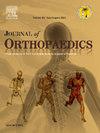全髋关节和膝关节置换术中补充睾酮的地域发生率
IF 1.5
Q3 ORTHOPEDICS
引用次数: 0
摘要
导言:2013 年后,有报告称睾酮与心肌梗死和中风有关,因此美国的睾酮处方用量有所下降。然而,最近有记录显示睾酮处方有所增加。最近,有人假设睾酮水平会增加接受选择性肩关节置换术患者的感染风险。此外,睾酮还可能增加静脉血栓栓塞的风险。这些并发症都是全髋关节和膝关节置换术(THA/TKA)围手术期需要关注的问题。因此,我们的研究旨在根据地域人口数据确定接受 THA/TKA 的患者中睾酮处方的发生率趋势。方法我们使用商业索赔数据库回顾了 2016 年 1 月 1 日至 2021 年 12 月 31 日期间为男性实施的 40,711 例初级 THAs 和 50,893 例初级 TKAs。对记录中的人口统计学、地理位置和手术前 1 年内的补充睾酮处方进行了审查。根据美国人口普查数据对患者所在的大都会统计区(MSA)进行了评估。结果我们确定了91,604名男性接受了初级THA(n = 40,711)或TKA(n = 50,893)手术。在 THA/TKA 患者中,年龄较小的患者使用补充睾酮处方的可能性较高(OR = 0.99,95 % CI [0.99-1.00],p < 0.001)。TKA患者(2,507人,4.9%)的睾酮处方率高于THA患者(1,413人,3.4%),(OR = 1.44 95 % CI [1.35, 1.54],p <0.001)以及每年内的睾酮处方率。就 THA 和 TKA 患者而言,中西部(OR = 1.61,p < 0.001)、南部(OR = 3.04,p < 0.001)和西部(OR = 2.28,p < 0.001)地区患者的睾酮处方率均高于东北部地区。结论进行 TKA/THA 手术的外科医生应该注意,年轻患者、人口较多地区的患者以及中西部、南部和西部地区的患者比东北部地区的患者更有可能获得睾酮处方。本文章由计算机程序翻译,如有差异,请以英文原文为准。
Geographical incidence of testosterone supplementation in total hip and knee arthroplasty
Introduction
Prescription testosterone usage in the United States declined after 2013 following reports of its association with myocardial infarction and stroke. However, more recently there has been a documented increase in testosterone prescriptions. Recently, testosterone levels have also been hypothesized to increase infection risk in patients undergoing elective shoulder arthroplasty. Furthermore, testosterone may increase the risk of venous thromboembolism. These complications are perioperative concerns for total hip and knee arthroplasties (THA/TKA). Therefore, the purpose of our study is to identify trends in the incidence of testosterone prescriptions in patients who underwent THA/TKA with respect to geographical population data.
Methods
We retrospectively reviewed 40,711 primary THAs and 50,893 primary TKAs performed in males between 1/1/2016 and 12/31/2021 using a commercial claims database. Records were reviewed for demographics, geographical location, and supplemental testosterone prescriptions within 1 year prior to surgery. Patient Metropolitan Statistical Area (MSA) was assessed with respect to United States Census Population Data.
Results
We identified 91,604 males who underwent primary THA (n = 40,711) or TKA (n = 50,893). For THA/TKA, patients who were younger had a higher likelihood of having a supplemental testosterone prescription (OR = 0.99, 95 % CI [0.99–1.00], p < 0.001). TKA patients (2,507, 4.9 %) had a higher rate of testosterone prescriptions than THA patients overall (1,413, 3.4 %), (OR = 1.44 95 % CI [1.35, 1.54], p < 0.001) as well as within each year.
For THA and TKA patients, patients in the Midwest (OR = 1.61, p < 0.001), South (OR = 3.04, p < 0.001), and West (OR = 2.28, p < 0.001) regions all had higher testosterone prescription rates than the Northeast. Patients living in a city (MSA population ≥200,000) were more likely to be prescribed testosterone (OR = 1.20, p = 0.002).
Conclusion
Surgeons conducting TKA/THA should be aware that younger patients, those in higher population areas, and those in the Midwest, South, and West regions are more likely to be prescribed testosterone than those in the Northeast.
求助全文
通过发布文献求助,成功后即可免费获取论文全文。
去求助
来源期刊

Journal of orthopaedics
ORTHOPEDICS-
CiteScore
3.50
自引率
6.70%
发文量
202
审稿时长
56 days
期刊介绍:
Journal of Orthopaedics aims to be a leading journal in orthopaedics and contribute towards the improvement of quality of orthopedic health care. The journal publishes original research work and review articles related to different aspects of orthopaedics including Arthroplasty, Arthroscopy, Sports Medicine, Trauma, Spine and Spinal deformities, Pediatric orthopaedics, limb reconstruction procedures, hand surgery, and orthopaedic oncology. It also publishes articles on continuing education, health-related information, case reports and letters to the editor. It is requested to note that the journal has an international readership and all submissions should be aimed at specifying something about the setting in which the work was conducted. Authors must also provide any specific reasons for the research and also provide an elaborate description of the results.
 求助内容:
求助内容: 应助结果提醒方式:
应助结果提醒方式:


